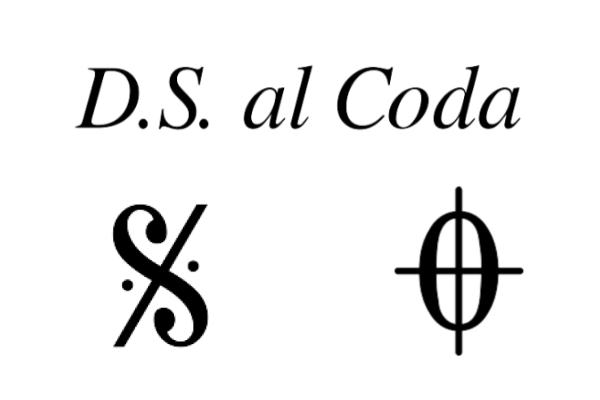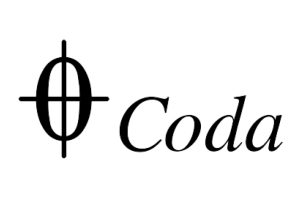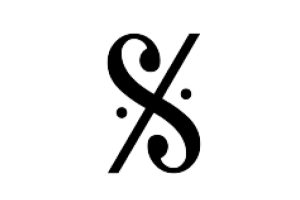The D.S. al Coda definition can help you avoid humiliation during rehearsals.

Grab the cheat sheets.
There is a strange marking in your music that says D.S. al Coda. Not knowing what to do, you give it a good guess and end up playing a solo. Everyone else has stopped playing, but you keep going. Has this happened to you?
It’s a little bit embarrassing. An unplanned solo in band or orchestra is something no one wants to experience. Not unless you enjoy having a hundred eyes glaring at you in rehearsal because you have to start over.
There is an easier way and I’ll show you how. It might save you some embarrassment and people getting frustrated with you.
Let’s begin with a brief overview and then dive right in.
- The D.S. al Coda definition can help you avoid humiliation during rehearsals.
- What is D.S. al Coda?
- D.S. al Coda Definition
- Dal Segno Abbreviation (D.S.)
- What is the Purpose of D.S. al Coda?
- D.S. al Coda Example
- How Do You Read D.S. al Coda?
- Step 1 – Start from the beginning of the music and play until you see the written words D.S. al Coda.
- Step 2 – Return back to the "S" sign or Segno sign.
- Step 3 – From the Segno sign, repeat playing or signing the section again until the Coda sign.
- Step 4 – Once you arrive at the Coda sign, skip to the Coda (which includes both the symbol and written word) and play until the end.
- Coda Section
- What Does Coda Mean?
- Coda Sign
- Is the Coda Sign the Same as the Coda Symbol?
- Coda Symbol
- How to Use D.S. al Coda
- 1. Start at the beginning and play until you see D.S. al Coda.
- 2. Go back to the “S” sign and repeat this passage.
- 3. Keep playing until you see the symbol of an oval with a cross inside. This is a Coda sign telling you to skip to the labeled Coda section.
- 4. Go directly to the Coda and keep playing all the way to the end.
- What Does Dal Mean in Music?
- What is a Segno in Music?
- What Does Dal Segno Mean in Music?
- Dal Segno Definition
- What Does Dal Segno Look Like?
- Dal Segno Sign
- More Dal Segno Meanings
- Al Coda Meaning
- What Does Dal Segno al Coda Mean?
- What Do You Do When It Says To Coda?
- D.S. al Coda Definition Review
- Quick Practice Tips

What is D.S. al Coda?
D.S. al coda, also called dal segno al coda, is an Italian music term that means “from the sign to the coda mark.” It means to play until you see the words D.S. al coda, go back to the Segno sign, then play until the Coda sign, and finally skip to the Coda section.
This type of sheet music directional marking has two key components: 1) a repetition, and 2) a skip that takes you to the end of the piece. In general, it is just another type of repeat that is written out differently. It has many similarities to a sectional repeat in a song structure.
I’m sure this sounds confusing right now, but it will all make sense in just a moment. Moving on to the definition.
D.S. al Coda Definition
The D.S. al Coda definition instructs musicians to go back to the “S” sign and play the musical passage again until reaching the measure marked with a Coda (or To Coda) sign. Do this once the written D.S. al Coda directions appear in your music. Then, jump to the Coda and play to the end.
Dal Segno Abbreviation (D.S.)
The abbreviation for Dal Segno is D.S. When this musical term is translated from Italian into the English language, it literally means “from the sign.” It instructs an instrumentalist to return to the sign and leap to the coda symbol when Al coda or To coda is reached.
According to Wikipedia, it tells a performer to start at the Segno sign and repeat a section of music. In the case of D.S. al Coda, a musician plays the music again from the “S” sign until you see the Coda sign. Then, skip to the Coda and play until the end.
What is the Purpose of D.S. al Coda?
The main purpose of D.S. al Coda is to reduce the amount of music needed to compose a song. In composition, it is not necessary to write down additional measures when using this shortened musical word. It saves time, pages, and the total amount of music to read.
It is much easier to understand what this marking instructs you to do with an example from a piece of music.
D.S. al Coda Example
Take a look at the D.S. al Coda example below.

You will notice an “S”-shaped symbol in the music. This is the Segno sign. You will also see the instructions that say “D.S. al Coda.” Another symbol to notice is the coda sign and the coda symbol paired with the written word “Coda” towards the end.
Not sure how to read it? Let’s keep going using the same example above.
How Do You Read D.S. al Coda?
Follow these instructions to learn how to read D.S. al Coda when it appears in your music.
Step 1 – Start from the beginning of the music and play until you see the written words D.S. al Coda.
Step 2 – Return back to the “S” sign or Segno sign.
Step 3 – From the Segno sign, repeat playing or signing the section again until the Coda sign.
Step 4 – Once you arrive at the Coda sign, skip to the Coda (which includes both the symbol and written word) and play until the end.
This final area that you play until the end is called the coda section.
Coda Section
The coda section in music is the concluding part that ends a composition or a movement. There is no limit to how lengthy it may be. It can range from a few measures to a full section.
What Does Coda Mean?
Coda is an Italian musical term that means the end or a concluding passage in English. At the end of a music page or movement, you might find a separate section labeled “Coda”. It is the last thought before wrapping up the song or movement entirely.
You will notice there is a double bar or double bar lines at the beginning of the Coda section. The purpose of the double bar is to separate this section and mark it clearly as the last passage before the end.
Remember, the final double bar or final double bar lines are always a good indication of where the end of a song truly is.

Coda Sign
The coda sign is a directional music marking used as a navigational tool in sheet music. It indicates to skip straight to the Coda section and play until the end. A musician follows along in the sheet music until this point and then jumps to the concluding Coda section.
Is the Coda Sign the Same as the Coda Symbol?
The coda sign and the coda symbol are exactly the same. They are both used as a musical mark giving directions to repeat a section and skip to the end. Both terms are commonly used interchangeably.
Coda Symbol
The Coda symbol (otherwise known as the Coda sign) looks like an oval with a cross in the center. You can also think of it as a large whole note turned sideways with a perpendicular and horizontal line running through it. In music notation, this symbol is used to indicate an exit from a repeated section followed by a jump to the ending Coda section.
Now that you know what it is, here’s how to put it to work for you.
How to Use D.S. al Coda
Quickly learn how to use D.S. al Coda in 4 easy steps so that you know what to do when you see it in your music. As a result, you’ll never have to deal with a humiliating solo again.
1. Start at the beginning and play until you see D.S. al Coda.
2. Go back to the “S” sign and repeat this passage.
3. Keep playing until you see the symbol of an oval with a cross inside. This is a Coda sign telling you to skip to the labeled Coda section.
4. Go directly to the Coda and keep playing all the way to the end.
As a general rule, whenever you see the Coda sign in your music, this means to skip directly to the Coda section. The Coda section is an added ending usually marked with the same sign.
Now that you know how to put the D.S. al Coda meaning into practice, let’s break it down even further.

What Does Dal Mean in Music?
The Italian musical term Dal means “from the” or “by the” in music. In this case, it is the first part of the music term Dal Segno which indicates “from the Segno.”
This leads us to the next part.

What is a Segno in Music?
A Segno in music is a notational sign or symbol found in sheet music. It is in the shape of an “S” giving it the more common layman’s name as the “S sign.” It marks the beginning of a repeat.
What Does Dal Segno Mean in Music?
Dal Segno in music literally means “from the sign.” Musicians use this as a signal to go back to the Segno sign, which marks the start of a repetition. Putting both meanings of Dal and Segno together as “Dal Segno” translates from Italian to English as “from the sign.”
The separate meanings of both music terms can be found in The A to Z of Foreign Musical Terms book. This is an excellent book to keep on your shelf.
According to the Merriam-Webster Dictionary, Segno is a notational sign indicating when a musical repetition begins or ends. This leads us to a fuller definition of Dal Segno in music, but it still needs a little help.
Dal Segno Definition
A simple definition of Dal Segno is to repeat from the sign. The sign referred to in this case is the Dal Segno sign. This means the musical passage from the point marked by the sign is repeated.
What Does Dal Segno Look Like?
The Dal Segno symbol looks like a squiggly “S” with a line and two dots in the middle. We see this music symbol more often at the conclusion of a piece.
Dal Segno Sign
The Dal Segno sign is a symbol with an “S” shape that has an angled line through the center with a dot on each side. The line and two dots are similar in appearance to a repeat sign. The Dal Segno symbol, like a repeat sign, invites us to go back and play.
More Dal Segno Meanings
Here are a few more Dal Segno meanings from a few different reliable sources.
The New Harvard Dictionary of Music says that Dal Segno means to repeat a musical passage beginning with the measure marked with a Dal Segno sign. This clearly tells us the music is to be repeated “from the sign.” The same definition appears in The Harvard Concise Dictionary of Music and Musicians.
Al Coda Meaning
The al Coda meaning in music is “to the end.” When broken apart, Al in Italian means “to the” in English and Coda means “end.” It becomes Dal Segno al Coda when the two words are reassembled, with Dal Segno at the front. These Italian words and symbols representing repetition are commonly used together.
What Does Dal Segno al Coda Mean?
Dal Segno al Coda means “from the sign to the end.” Most often it is abbreviated as D.S. al Coda. No matter how it is written, it means to return to the Dal Segno sign and play again until the Coda sign which signals to jump ahead to the Coda section.
What Do You Do When It Says To Coda?
To Coda is sometimes written alone or with the Coda sign in music. It means the same as the Coda symbol. While performing the final repetition and reaching To Coda, musicians should jump to the separate section identified with the coda symbol and the word Coda. Note that this is the coda section.
Is your head spinning yet? Let’s do a quick review.
D.S. al Coda Definition Review
According to the D.S. al Coda definition, always be sure to: 1) repeat from the “S” sign (or Dal Segno sign) and play to the Coda sign, then 2) skip to the Coda section and play to the end.
Now you know exactly where the repeat is and the location of the skip in your music as indicated by this type of musical direction term.
Quick Practice Tips
Always look for musical terms like this before you begin a piece. Take a moment to think about what you need to do in order to play all the way to the end.
Don’t be afraid to write reminders in your music with a pencil drawing extra attention to these directions. Consider using removable sticky document arrows like these to make sure you don’t forget what to do. They are very useful and can be reused.
Don’t let these markings scare you. In about 4 easy steps, you are ready to start playing with confidence!

Grab the cheat sheets.

Thanks for that clear and helpful description
Thanks for the refresher! Very easy to understand. Loved the visual
Thanks for your help. It’s very clearly and easy to understand.
I learned that D.S. directs me to go back to the “sign,” ( usually an embellished “S” atop the music notes ), and then continue playing, either to the end, or to a Coda sign, or AlCoda, which directs me to go to the Coda which becomes the end. I Look forward to working it out on some music I have handy.
I acknowledge the clarity of your teaching. Thank you for your commitment to having us know. Best wishes,
David
This is a great explanation!
This was a great help, Teresa. Thank you for your clear and concise explanation. Itès a great help to someone like me who is getting back into music, vocally, after many years. Blessing to you.
Just found your website while getting some help on DS al Coda and the funky s/s sign. Helped a lot-thanks.
Great encouraging words, too. Need those!
Mary M.
Excellent instructions!
Thank you for the clear explanation!
Thank you! Helped me help my granddaughter get unstuck!
Thank you so much! I am new to sheet music and melodic perc. These D.S. and D.C. articles helped me better understand!
Excellent explanation! Thank you for your clarity!! It is greatly appreciated!
I am a senior who is back playing my instrument. So their is enough about music to recollect from the past, and I never thought that Al Coda and its symbols would create any problems. I found myself getting lost in my pieces and figured out that I’m not reading Al coda correctly. Your clear explanation above is excellent. It is a refresher. Thank You.
Waltz from The Sleeping Beauty Tchaikovsky, ( arranged by Leland Forsblad) D.S. al Coda ( at 124) then to back to S sign (77) and repeat passage.
Then…Keep playing till I see the Oval symbol with the cross, (125) then to To Coda (90 ) then play until the end?
Is this correct?
Thank You
I have Violin 1 while playing flute
Hi came across you by accident. I think you are great and kind. God bless. Please keep educating me. I am a retired dentist trying to catch up on what I did not have time to do.
Cheers. Keep well
Camillus
Bailiff Bridge
Brighouse
West Yorkshire
U.K.
Thank you very much!!! No if I could only play the piano.
(I don’t know what a gravatar is.)
(I play a little.)
I came across you after noting the title of an “Endeavor”, TV, episode as “coda.” I recognized it as a musical term but didn’t know what it meant. So I looked it up on the Internet, and there you were.
I made a great choice, because you’ve given us a beautiful explanation.
Thank you.
this was really helpful. thanks.